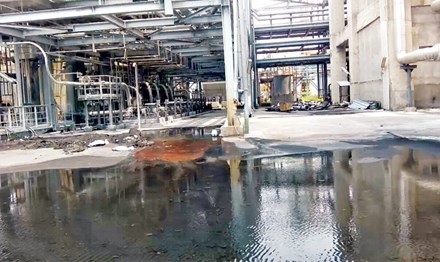Ninh Binh fertiliser plant permanently suspends operation
 |
The plant’s construction was kicked off in May 2008 in Ninh Binh’s Khanh Phu industrial zone and came into operation in 2012, after 42 months of construction.
In the nearly four years since then, the plant has been continuously operating at a deficit, accumulating altogether over VND2 trillion ($89.9 million) in losses. Notably, in 2012, the company’s losses amounted to VND75 billion ($3.37 million), which increased to VND759 billion ($34.12 million) in 2013, VND500 billion ($22.48 million) in 2014, and VND370 billion ($16.63 million) in 2015.
The plant was forced to call a temporary halt to its operations in late March, however, Vinachem has decided against opening the plant’s gates again. The company has temporarily laid off 400 of its 1,100 workers, paying the monthly unemployment allowance of VND3.1 million ($139.37) each worker.
According to Nguyen Gia The, deputy general director of Ninh Binh nitrogenous fertiliser plant, the company has difficulties maintaining operations because the already high production expenditures are increasing even further, while fertiliser prices are in a continuous plunge on the domestic market. At present, the plant is storing approximately 50,000 tonnes of unsold fertiliser.
Exacerbating the company’s difficulties, the plant was equipped with low-quality Chinese machinery, leading to high maintenance expenses that contributed to the suspending of operations.
Along with its losing operation, the plant also caused serious environmental damage by discharging untreated wastewater into the Day River, only three months after it started operations. During an unannounced inspection in October 2012, the Police Department for Environmental Crime Prevention and Control (C49) detected that the plant discharged a wastewater volume of 5,000 cubic metres per hour, causing a massive wave of death in fish stock and cattle in the nearby region.
With an annual output of 560,000 tonnes, the plant was expected to meet 25 per cent of the country's demand for urea fertiliser, helping the nation save $250 million on imports.
Together with the fertiliser plants in Phu My, Ca Mau, and Ha Bac, the plant was to meet the country's demand for urea nitrogenous fertilisers and help stabilise Vietnamese fertiliser production, and contribute to national food security.
What the stars mean:
★ Poor ★ ★ Promising ★★★ Good ★★★★ Very good ★★★★★ Exceptional
Latest News
More News
- Vietnam GDP posts second-strongest growth since 2011 (January 06, 2026 | 08:35)
- Double-digit GDP growth within reach with shift to higher-value expansion (January 06, 2026 | 08:33)
- Ho Chi Minh City projects $10.5 billion remittance inflows in 2025 (December 31, 2025 | 18:58)
- Digital shift reshaping Vietnam’s real estate brokerages (December 31, 2025 | 18:54)
- New decree sharpens enforcement in securities market (December 31, 2025 | 18:53)
- Voluntary Sustainability Standards pave way for Vietnam’s agricultural exports (December 31, 2025 | 09:00)
- Gold market reform advances as SBV receives applications for bullion production (December 30, 2025 | 12:07)
- Textile apparel firms deliver robust earnings despite global tariff pressures (December 30, 2025 | 10:09)
- Ho Chi Minh City hits $8.37 billion in FDI (December 29, 2025 | 08:28)
- Tax sector wraps up 2025 and sets priorities for next year (December 25, 2025 | 14:00)

















 Mobile Version
Mobile Version